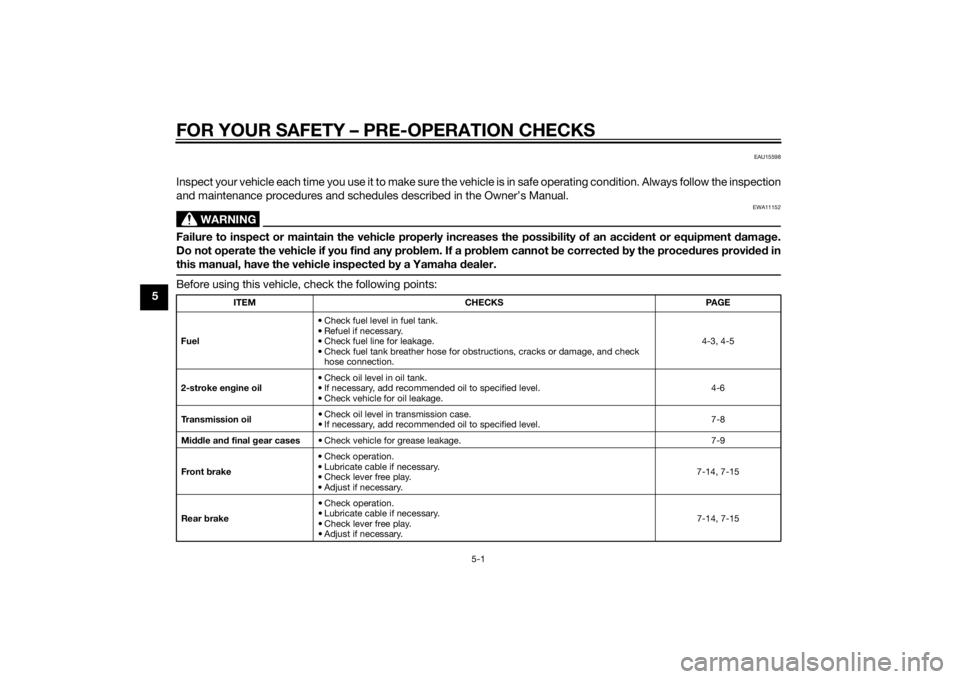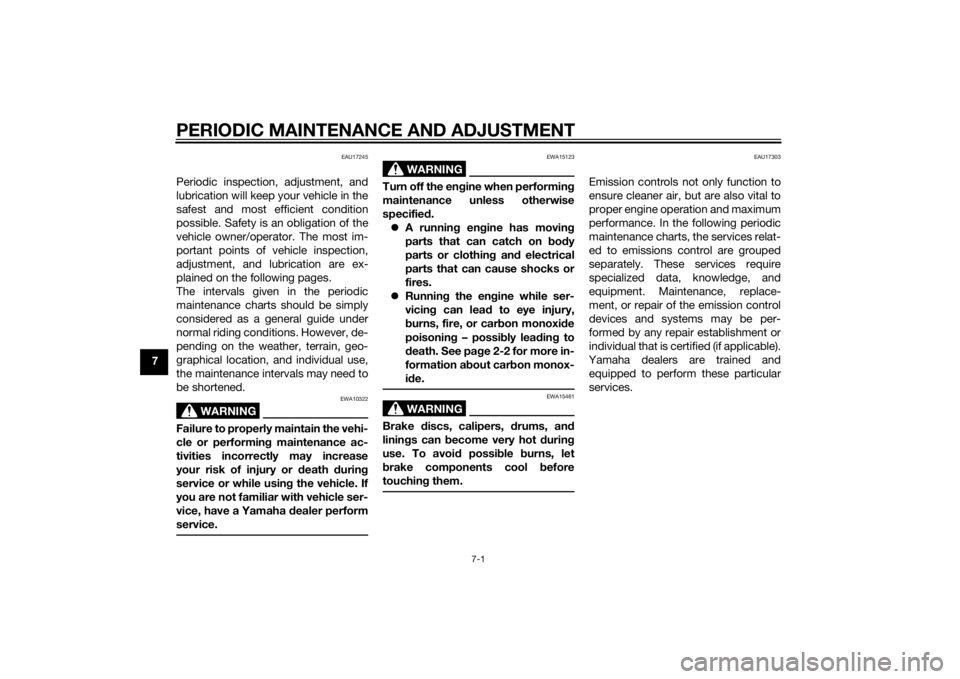2015 YAMAHA PW50 maintenance
[x] Cancel search: maintenancePage 5 of 76

INTRODUCTION
EAU41075
Congratulations on your purchase of the Yamaha PW50/PW50F/PW50F1. This model is the result of Yamaha’s vast expe-
rience in the production of fine sporting, touring, and pacesetting racing machines. It represents the high degree of crafts-
manship and reliability that have made Yamaha a leader in these fields.
This manual will give you an understanding of the operation, inspection, and basic maintenance of this motorcycle. If you
have any questions concerning the operation or maintenance of your motorcycle, please consult a Yamaha dealer.
The design and manufacture of this Yamaha motorcycle fully comply with the emissions standards for clean air applicable
at the date of manufacture. Yamaha has met these standards without reducing the performance or economy of operation
of the motorcycle. To maintain these high standards, it is important that you and your Yamaha dealer pay close attention
to the recommended maintenance schedules and operating instructions contained within this manual.
Yamaha continually seeks advancements in product design and quality. Therefore, while this manual contains the most cur- rent product information available at the time of printing, there may be minor discrepancies between your motorcycle and
this manual. If there is any question concerning this manual, please consult a Yamaha dealer.
WARNING
EWA10032
Please rea d this manual carefully an d completely before operatin g this motorcycle.
WARNING
EWA14352
This motorcycle is d esigne d an d manufactured for off-road use only. It is ille gal to operate this motorcycle on any
pu blic street, roa d or hi ghway. Such use is prohi bite d b y law. This motorcycle complies with almost all state off-
hi ghway noise level an d spark arrester laws an d re gulations. Please check your local ri din g laws an d re gulations
b efore operatin g this motorcycle.AN IMPORTANT SAFETY MESSAGE:
Read this manual carefully and completely before operating this motorcycle. Make sure you understand all instructions.
Pay close attention to the warning and notice labels on the motorcycle.
Never operate a motorcycle without proper training or instruction.
Weight of the rider should not exceed 25 kg (55 lb).
U2SA81E0.book Page 1 Monday, June 2, 2014 2:00 PM
Page 6 of 76

INTRODUCTIONAN IMPORTANT NOTE TO PARENTS:
This motorcycle is not a toy. Before you let your child ride this motorcycle, you should understand the instructions and warn-
ings in this Owner’s Manual. Then be sure your child understands and will follow them. Children differ in skills, physical abil-
ities, and judgment. Some children may not be able to operate a motorcycle safely. Parents should supervise their child’s
use of the motorcycle at all times. Parents should permit continued use only if they determine that the child has the ability
to operate the motorcycle safely.
Your motorcycle is equipped with an adjustable speed limiter and a power reduction plate. Yamaha recommends that all
beginners start off with the speed limiter adjusting screw turned in and the power reduction plate installed in the exhaust
manifold to limit the power available while they learn. The limiter screw may be gradually turned out to increase maximum
speed as the beginner becomes more familiar with operating the motorcycle. Parents should decide when to adjust the
motorcycle for more power as their youngster’s riding skills improve. Once the rider can operate with skill at the top speed
permitted by adjusting the speed limiter alone, the power reduction plate can be removed. Since removal of this plate will
result in a significant increase in power, turn the speed limiter back in again; adjust it out in stages as you did before.
Motorcycles are sin gle track vehicles. Their safe use an d operation are d ependent upon the use of proper ri din g
techniques as well as the expertise of the operator. Every operator shoul d know the followin g requirements b efore
ri din g this motorcycle.
He or she should: Obtain thorough instructions from a competent source on all aspects of motorcycle operation.
Observe the warnings and maintenance requirements in this Owner’s Manual.
Obtain qualified training in safe and proper riding techniques.
Obtain professional technical service as indicated in this Owner’s Manual and/or when made necessary by mechanical
conditions.U2SA81E0.book Page 2 Monday, June 2, 2014 2:00 PM
Page 9 of 76

TABLE OF CONTENTS
LOCATION OF IMPORTANT
LABELS..............................................1-1
SAFETY INFORMATION ...................2-1
DESCRIPTION ...................................3-1
Left view ..........................................3-1
Right view ........................................3-2
Controls and instruments ................3-3
INSTRUMENT AND CONTROL
FUNCTIONS .......................................4-1
Handlebar switch ............................4-1
Speed limiter and power reduction plate .............................................4-1
Front brake lever .............................4-2
Rear brake lever ..............................4-3
Fuel tank cap ...................................4-3
Fuel ..................................................4-3
Fuel tank breather hose...................4-5
2-stroke engine oil ...........................4-6
Fuel cock .........................................4-6
Starter (choke) lever .......................4-7
Kickstarter .......................................4-7
Seat .................................................4-7
Cable lock (for Europe) ....................4-8 FOR YOUR SAFETY –
PRE-OPERATION CHECKS
............. 5-1
OPERATION AND IMPORTANT
RIDING POINTS ................................ 6-1
Starting and warming up a cold engine .......................................... 6-1
Starting a warm engine................... 6-1
Starting off ...................................... 6-2
Acceleration and deceleration ........ 6-2
Braking............................................ 6-2
Engine break-in............................... 6-3
Parking ............................................ 6-4
PERIODIC MAINTENANCE AND
ADJUSTMENT .................................. 7-1
Owner’s tool kit............................... 7-2
Periodic maintenance chart for the
emission control system ............. 7-3
General maintenance and
lubrication chart .......................... 7-4
Checking the spark plug................. 7-6
Removing the power reduction plate............................................. 7-7
Transmission oil .............................. 7-8
Middle and final gear cases ............ 7-9
Cleaning the air filter element ......... 7-9
Cleaning the spark arrester .......... 7-10
Adjusting the carburetor ............... 7-11
Adjusting the engine idling speed......................................... 7-11 Checking the throttle grip free
play ............................................ 7-12
Tires .............................................. 7-12
Panel wheels ................................. 7-14
Adjusting the front and rear brake lever free play ............................ 7-14
Checking the front and rear brake shoes ......................................... 7-15
Checking and lubricating the cables ........................................ 7-16
Checking and lubricating the
throttle grip and cable ............... 7-16
Adjusting the Autolube pump ....... 7-16
Lubricating the front and rear brake levers ............................... 7-17
Checking and lubricating the centerstand ................................ 7-17
Checking the front fork ................. 7-17
Checking the steering ................... 7-18
Checking the wheel bearings ........ 7-18
Front wheel ................................... 7-19
Rear wheel .................................... 7-20
Troubleshooting ............................ 7-23
Troubleshooting chart ................... 7-24
MOTORCYCLE CARE AND
STORAGE .......................................... 8-1
Matte color caution ......................... 8-1
Care................................................. 8-1
Storage............................................ 8-3
U2SA81E0.book Page 1 Monday, June 2, 2014 2:00 PM
Page 20 of 76

2-1
2
SAFETY INFORMATION
EAU4093C
Be a Responsible Owner
As the vehicle’s owner, you are re-
sponsible for the safe and proper oper-
ation of your motorcycle.
Motorcycles are single-track vehicles.
Their safe use and operation are de-
pendent upon the use of proper riding
techniques as well as the expertise of
the operator. Every operator should
know the following requirements be-
fore riding this motorcycle.
He or she should: Obtain thorough instructions from
a competent source on all aspects
of motorcycle operation.
Observe the warnings and mainte-
nance requirements in this Own-
er’s Manual.
Obtain qualified training in safe
and proper riding techniques.
Obtain professional technical ser-
vice as indicated in this Owner’s
Manual and/or when made neces-
sary by mechanical conditions.
Never operate a motorcycle with-
out proper training or instruction.
Take a training course. Beginners
should receive training from a cer-
tified instructor. Contact an autho-
rized motorcycle dealer to find out
about the training courses nearest
you.
Safe Ri din g
Perform the pre-operation checks
each time you use the vehicle to make
sure it is in safe operating condition.
Failure to inspect or maintain the vehi-
cle properly increases the possibility of
an accident or equipment damage.
See page 5-1 for a list of pre-operation
checks. This motorcycle is designed for
off-road use only, therefore, it is il-
legal to operate it on public
streets, roads, or highways, even
a dirt or gravel one. Off-road use
on public lands may be illegal.
Please check local regulations be-
fore riding.
This motorcycle is designed to
carry the operator only. No pas-
sengers.
The failure of motorists to detect
and recognize motorcycles in traf-
fic is the predominating cause of
automobile/motorcycle accidents.
Many accidents have been
caused by an automobile driver
who did not see the motorcycle.
Making yourself conspicuous ap-
pears to be very effective in reduc-
ing the chance of this type of
accident.
Therefore:
• Wear a brightly colored jacket.
• Use extra caution when you are approaching and passing
through intersections, since in-
tersections are the most likely
places for motorcycle accidents
to occur.
• Ride where other motorists can see you. Avoid riding in another
motorist’s blind spot.
• Never maintain a motorcycle without proper knowledge.
Contact an authorized motorcy-
cle dealer to inform you on ba-
sic motorcycle maintenance.
Certain maintenance can only
be carried out by certified staff.U2SA81E0.book Page 1 Monday, June 2, 2014 2:00 PM
Page 31 of 76

INSTRUMENT AND CONTROL FUNCTIONS
4-4
4
3. Wipe up any spilled fuel immedi- ately. NOTICE: Immediately
wipe off spille d fuel with a clean,
d ry, soft cloth, since fuel may
d eteriorate painte d surfaces or
plastic parts.
[ECA10072]
4. Be sure to securely close the fuel tank cap.
WARNING
EWA15152
Gasoline is poisonous an d can cau-
se injury or death. Han dle gasoline
with care. Never siphon gasoline by
mouth. If you shoul d swallow some
g asoline or inhale a lot of gasoline
vapor, or get some g asoline in your
eyes, see your d octor immediately. If g
asoline spills on your skin, wash
with soap an d water. If gasoline
spills on your clothin g, chan ge your
clothes.
EAU41985
For Cana daNOTICE
ECA15591
Use only unlea ded g asoline. The use
of lead ed g asoline will cause severe
d amag e to internal en gine parts,
such as the piston rin gs as well as to
the exhaust system.Your Yamaha engine has been de-
signed to use regular unleaded gaso-
line with a pump octane number
[(R+M)/2] of 86 or higher, or a research
octane number of 91 or higher. If
knocking (or pinging) occurs, use a
gasoline of a different brand or premi- um unleaded fuel. Use of unleaded fuel
will extend spark plug life and reduce
maintenance cost.
Gasohol
There are two types of gasohol: gaso-
hol containing ethanol and that con-
taining methanol. Gasohol containing
ethanol can be used if ethanol content
does not exceed 10% (E10). Gasohol
containing methanol is not recom-
mended by Yamaha because it can
cause damage to the fuel system or
vehicle performance problems.
For Europe
NOTICE
ECA15591
Use only unlea
ded g asoline. The use
of lead ed g asoline will cause severe
d amag e to internal en gine parts,
such as the piston rin gs as well as to
the exhaust system.
1. Fuel tank filler tube
2. Maximum fuel level
2
1
Recommen
ded fuel:
REGULAR UNLEADED GASOLINE
ONLY
Fuel tank capacity:
2.0 L (0.53 US gal, 0.44 Imp.gal)
Recommen ded fuel:
REGULAR UNLEADED GASOLINE
ONLY
Fuel tank capacity:
2.0 L (0.53 US gal, 0.44 Imp.gal)
U2SA81E0.book Page 4 Monday, June 2, 2014 2:00 PM
Page 32 of 76

INSTRUMENT AND CONTROL FUNCTIONS
4-5
4Your Yamaha engine has been de-
signed to use regular unleaded gaso-
line with a research octane number of
95 or higher. If knocking (or pinging)
occurs, use a gasoline of a different
brand or premium unleaded fuel. Use
of unleaded fuel will extend spark plug
life and reduce maintenance costs.
For Oceania an
d South Africa
NOTICE
ECA15591
Use only unlea ded g asoline. The use
of lead ed g asoline will cause severe
d amag e to internal en gine parts,
such as the piston rin gs as well as to
the exhaust system.Your Yamaha engine has been de-
signed to use regular unleaded gaso-
line with a research octane number of
91 or higher. If knocking (or pinging)
occurs, use a gasoline of a different brand or premium unleaded fuel. Use
of unleaded fuel will extend spark plug
life and reduce maintenance costs.
EAU13414
Fuel tank
breather hoseBefore operating the motorcycle:
Check the fuel tank breather hose
connection.
Check the fuel tank breather hose
for cracks or damage, and replace
it if necessary.
Make sure that the fuel tank
breather hose is not blocked, and
clean it if necessary.
Recommen ded fuel:
REGULAR UNLEADED GASOLINE
ONLY
Fuel tank capacity:
2.0 L (0.53 US gal, 0.44 Imp.gal)
1. Fuel tank breather hose
1
U2SA81E0.book Page 5 Monday, June 2, 2014 2:00 PM
Page 36 of 76

FOR YOUR SAFETY – PRE-OPERATION CHECKS
5-1
5
EAU15598
Inspect your vehicle each time you use it to make sure the vehicle is in safe operating condition. Always follow the inspection
and maintenance procedures and schedules described in the Owner’s Manual.
WARNING
EWA11152
Failure to inspect or maintain the vehicle properly increases the possibility of an acci dent or equipment damag e.
Do not operate the vehicle if you fin d any pro blem. If a pro blem cannot be corrected b y the proce dures provi ded in
this manual, have the vehicle inspecte d b y a Yamaha dealer.Before using this vehicle, check the following points:
ITEM CHECKS PAGE
Fuel • Check fuel level in fuel tank.
• Refuel if necessary.
• Check fuel line for leakage.
• Check fuel tank breather hose for obstructions, cracks or damage, and check
hose connection. 4-3, 4-5
2-stroke en gine oil • Check oil level in oil tank.
• If necessary, add recommended oil to specified level.
• Check vehicle for oil leakage. 4-6
Tr a n s m i s s i o n o i l • Check oil level in transmission case.
• If necessary, add recommended oil to specified level.
7-8
Mi dd le an d final g ear cases • Check vehicle for grease leakage. 7-9
Front brake • Check operation.
• Lubricate cable if necessary.
• Check lever free play.
• Adjust if necessary. 7-14, 7-15
Rear brake • Check operation.
• Lubricate cable if necessary.
• Check lever free play.
• Adjust if necessary.
7-14, 7-15
U2SA81E0.book Page 1 Monday, June 2, 2014 2:00 PM
Page 42 of 76

PERIODIC MAINTENANCE AND ADJUSTMENT
7-1
7
EAU17245
Periodic inspection, adjustment, and
lubrication will keep your vehicle in the
safest and most efficient condition
possible. Safety is an obligation of the
vehicle owner/operator. The most im-
portant points of vehicle inspection,
adjustment, and lubrication are ex-
plained on the following pages.
The intervals given in the periodic
maintenance charts should be simply
considered as a general guide under
normal riding conditions. However, de-
pending on the weather, terrain, geo-
graphical location, and individual use,
the maintenance intervals may need to
be shortened.
WARNING
EWA10322
Failure to properly maintain the vehi-
cle or performing maintenance ac-
tivities incorrectly may increase
your risk of injury or death durin g
service or while usin g the vehicle. If
you are not familiar with vehicle ser-
vice, have a Yamaha d ealer perform
service.
WARNING
EWA15123
Turn off the en gine when performin g
maintenance unless otherwise
specified .
A runnin g en gine has movin g
parts that can catch on body
parts or clothin g an d electrical
parts that can cause shocks or
fires.
Runnin g the en gine while ser-
vicin g can lead to eye injury,
b urns, fire, or car bon monoxi de
poisonin g – possi bly lea din g to
d eath. See pag e 2-2 for more in-
formation a bout car bon monox-
i d e.
WARNING
EWA15461
Brake discs, calipers, drums, and
linin gs can b ecome very hot d uring
use. To avoi d possi ble burns, let
b rake components cool before
touchin g them.
EAU17303
Emission controls not only function to
ensure cleaner air, but are also vital to
proper engine operation and maximum
performance. In the following periodic
maintenance charts, the services relat-
ed to emissions control are grouped
separately. These services require
specialized data, knowledge, and
equipment. Maintenance, replace-
ment, or repair of the emission control
devices and systems may be per-
formed by any repair establishment or
individual that is certified (if applicable).
Yamaha dealers are trained and equipped to perform these particular
services.
U2SA81E0.book Page 1 Monday, June 2, 2014 2:00 PM